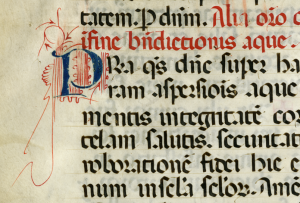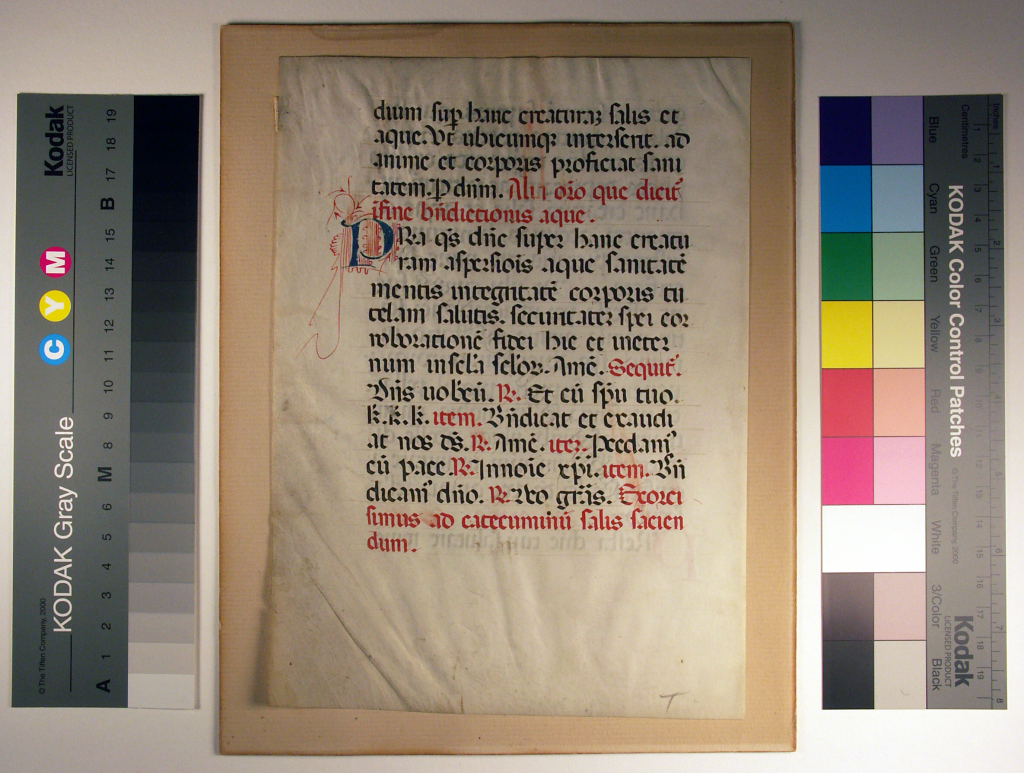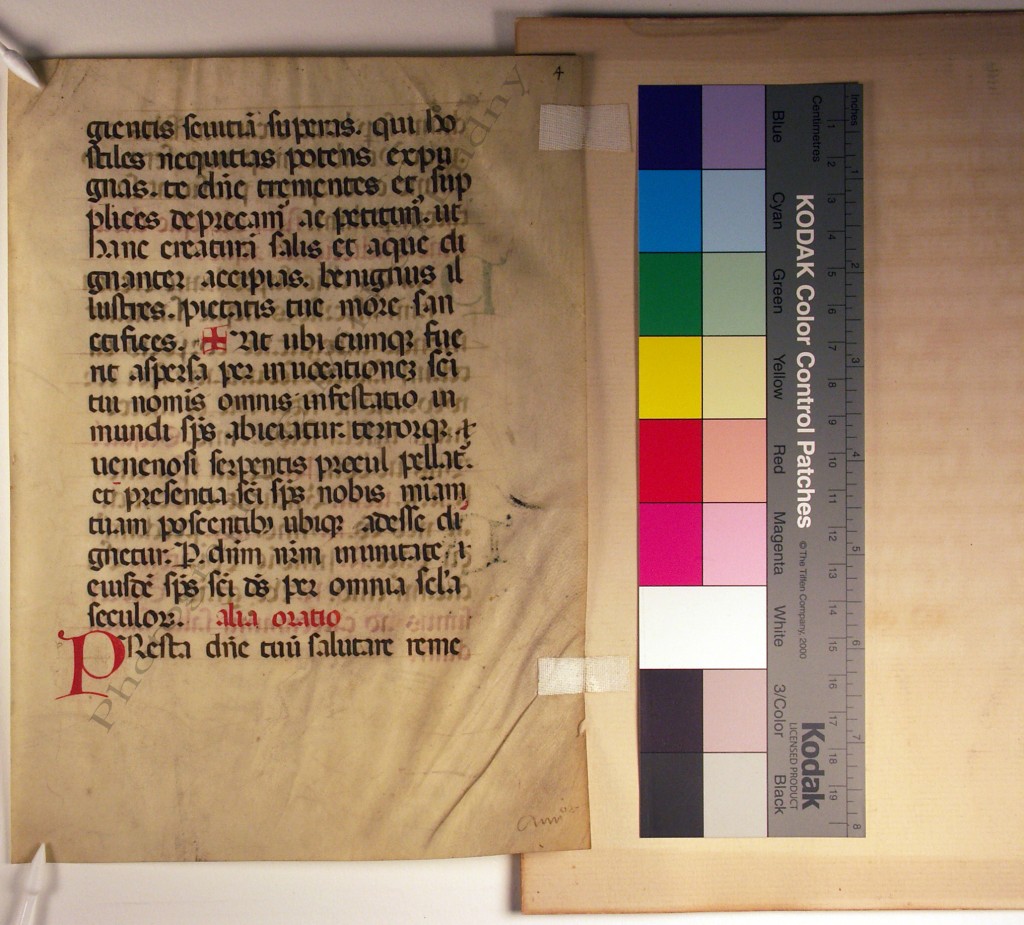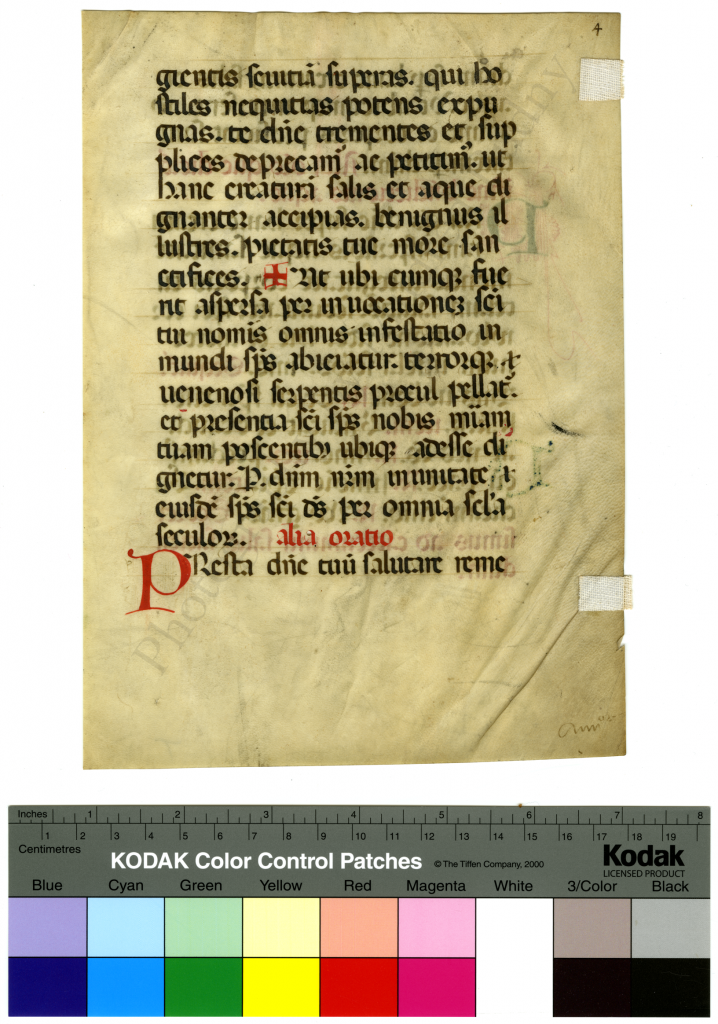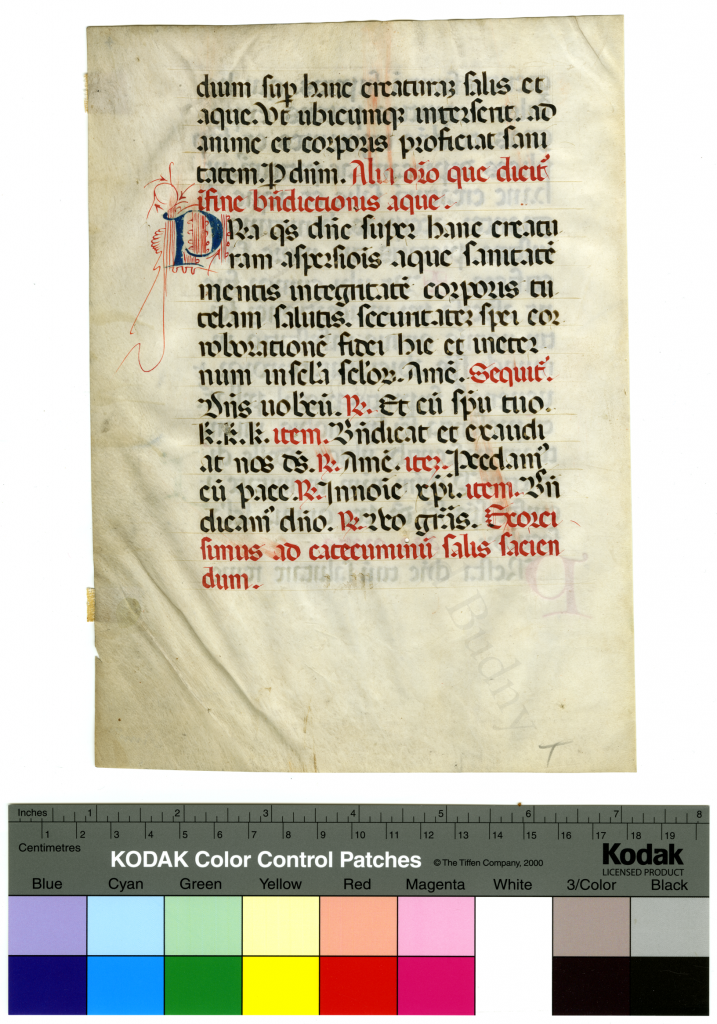Single Leaf on Paper from an
Early-Printed Latin Missal (Missale Romanum)
For use in a Carmelite Monastery
Part of the Mass for Holy Saturday (Sabbato Sancto)
Printed in 1509
by Lucantonio Giunta in Venice
in 2 columns of 36 lines
With Music on 4-Line Staves
J. S. Wagner Collection
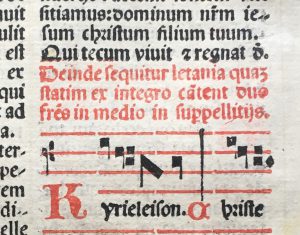
Another leaf from the J. S. Wagner Collection takes center stage as we examine its features. We thank the collector for allowing us to see and to show the material.
Other leaves from this collection are reported in earlier posts. They came from medieval manuscripts and stand on vellum.
*****
This time, the single leaf stands on paper and came from an early-printed Latin Missal. On paper. The form of book contains all the instructions and texts necessary for the celebration of the liturgical year.
We offer a description, identification, and 12-page downloadable Report. The Report, by our Associate and Font Designer, Leslie J. French, is available below. It is set in our copyright digital font Bembino (of course).
Worth saying that the printed leaf has sparked the interest of our Font Designer. Glad for his expert examination and exploration. This blogpost serves as a foundation, counterpart, and compliment to his report.
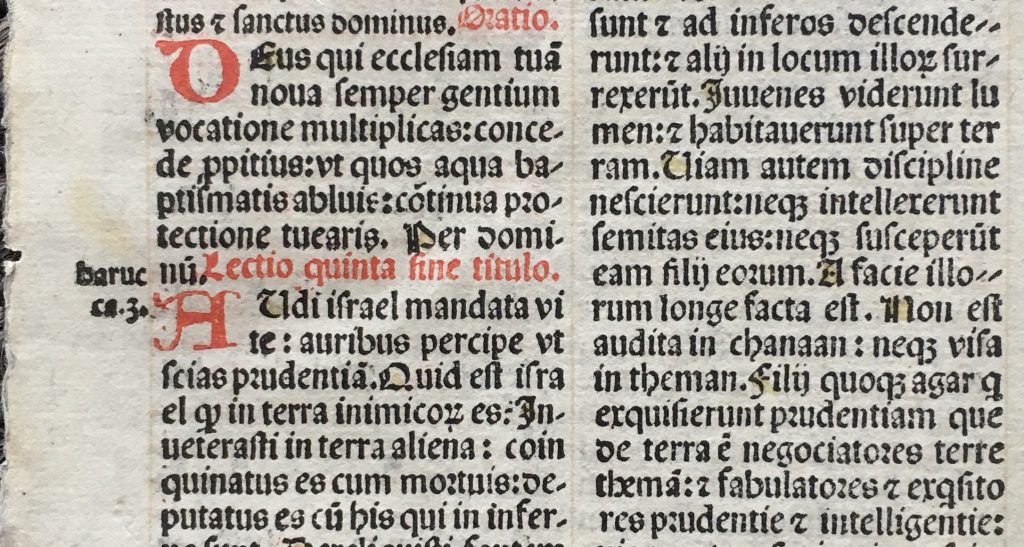
J. S. Wagner Collection, Single Leaf from a Latin Missal containing part of the Mass for Holy Saturday for use in a Carmelite Monastery, printed in 1509 Lucantonio Giunta in Venice. Recto, detail. Reproduced by Permission.
Other Materials from the Same Collection
The collector has generously shared with us images of some fragments, manuscript and printed. They include a leaf from a dismembered Vulgate Bible manuscript, now known as ‘Otto Ege Manuscript 19’, which occupied center stage in earlier blogposts.
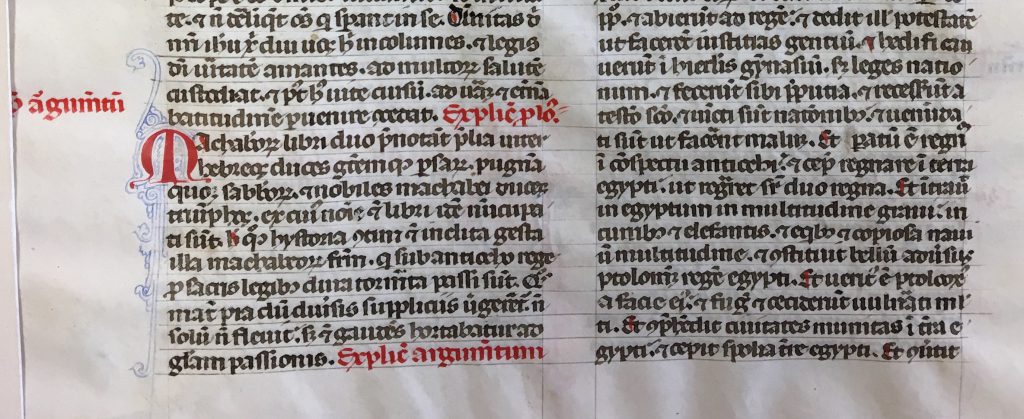
J. S. Wagner Collection, Ege Leaf 19, verso, detail.
Other leaves carry illustration or decoration (or both) as well as text. For example, The Penitent King David from a Book of Hours:
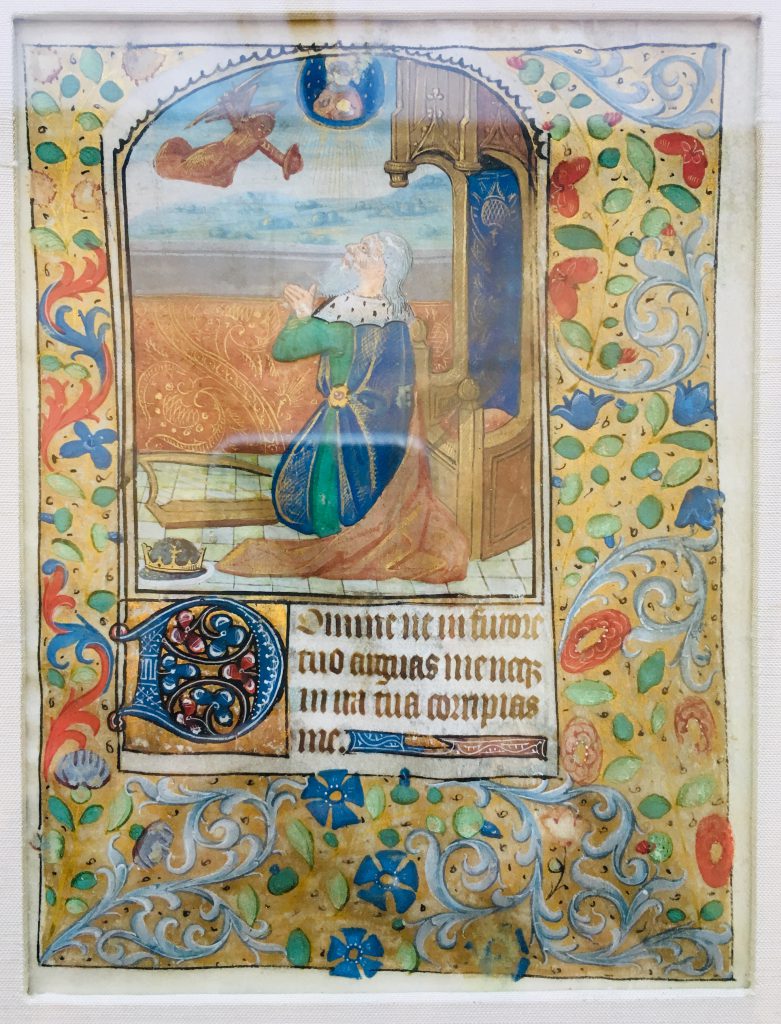
J. S. Wagner Collection. Detached Manuscript Leaf with the Opening in Latin of the Penitent Psalm 37 (38) and its Illustration of King David.
And A Leaf from Prime in a Large-Format Breviary :
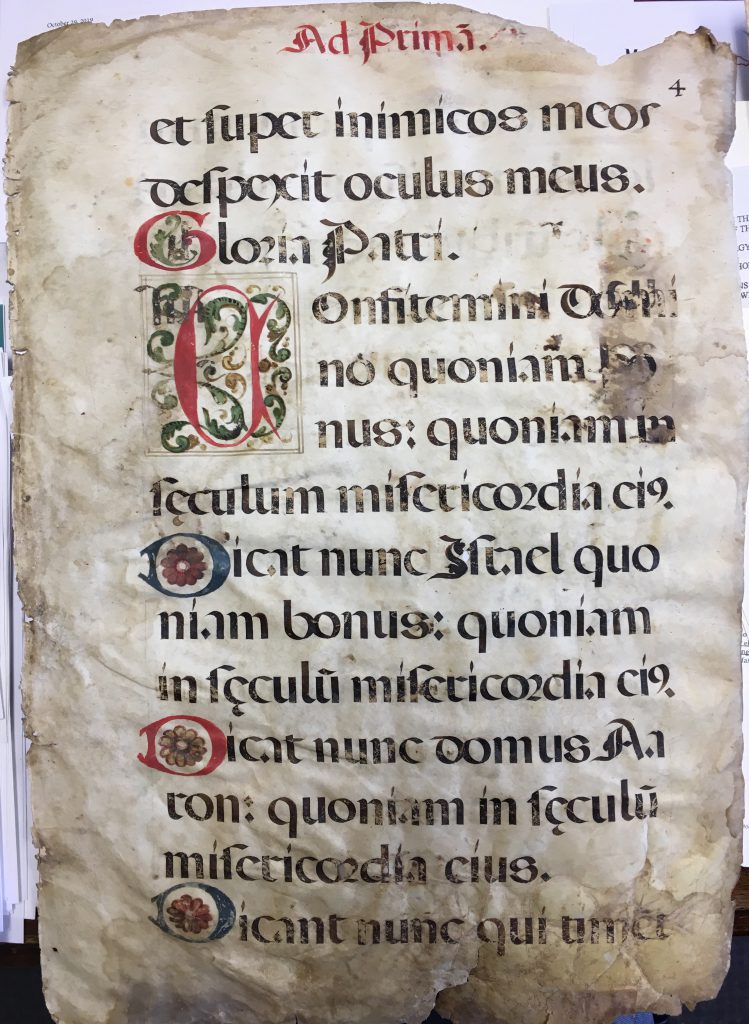
J. S. Wagner Collection. Leaf from from Prime in a Latin manuscript Breviary. Folio 4 Recto.
The Leaf in Question
The text on the leaf to which we turn now contains part of the Mass for Holy Saturday (Sabbato Sancto), including music with notation on staves, for use in a Carmelite Monastery, that is, Carmelites, known as the “Order of the Brothers of the Blessed Virgin Mary of Mount Carmel” (Ordo Fratrum Beatissimæ Virginis Mariæ de Monte Carmelo). The spiritual focus) of the Carmelite Order is contemplation, encompassing prayer, community, and service.
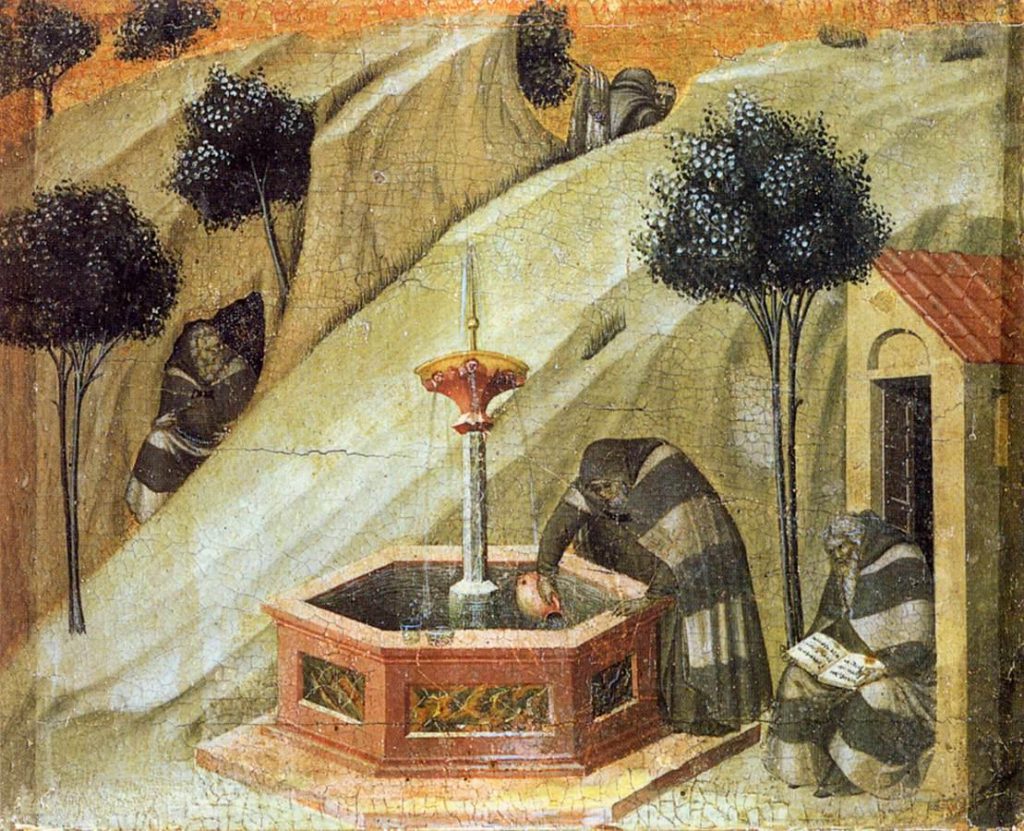
Pietro Lorenzetti, Predella panel. Carmelite Hermits at the Fountain of Elijah (1328-1329). Siena, Pinacoteca Nazionale di Siena. Image Public Domain, via Wikimedia Commons.
The features of the Missal Leaf, including fonts, demonstrate that it was printed by Lucantonio Giunta in Venice, Italy. That is, Lucantonio Giunti (or Giunta), prolific book publisher and printer, born in Florence and active in Venice from 1489.
The Numbers Game
The recto of the leaf carries the printed folio number cij. Numbers in pencil in the outer corners at top and bottom label it as folio 148 and as an item-of-some-kind number 49991. The unevenly cut inner edge more-or-less follows the fold-line between the leaf and its mate in the former bifolium, or pair of leaves which nested within the gathering of leaves. The inner edge retains the 5 more-or-less regularly spaced notches which were cut into the fold of the gathering in preparation for stitching the text-block into the binding. (According to Ligatus: The Language of Binding, such features are to be known as “knife-cut recesses”, thus defined.)
The top of the Recto, with alternate Folio numbers in print and in pencil:
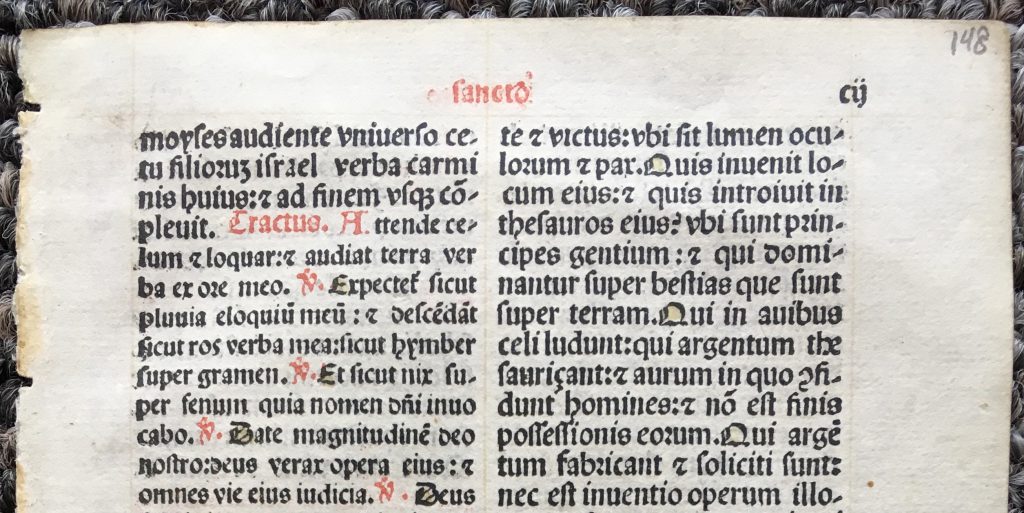
J. S. Wagner Collection, Single Leaf from a Latin Missal containing part of the Mass for Holy Saturday for use in a Carmelite Monastery, printed in 1509 Lucantonio Giunta in Venice. Recto, detail: Top Portion. Reproduced by Permission.
The bottom of the recto, with a large number very close to 50,000:
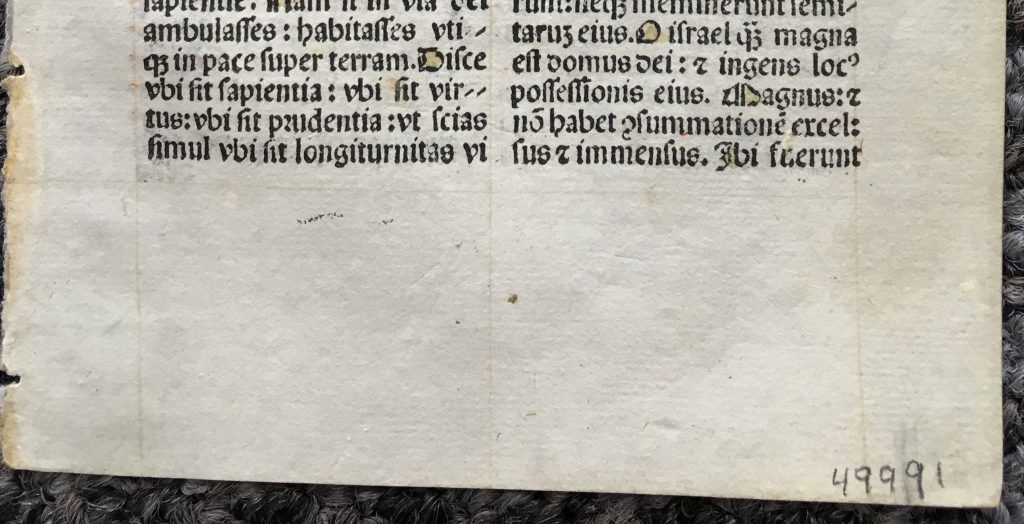
J. S. Wagner Collection, Single Leaf from a Latin Missal containing part of the Mass for Holy Saturday for use in a Carmelite Monastery, printed in 1509 by Lucantonio Giunta in Venice. Recto, detail: Bottom Portion. Reproduced by Permission.
The Leaf in Full
Recto and Verso, one by one. Let us have a look and turn the page.
Recto of Leaf Number CII/148
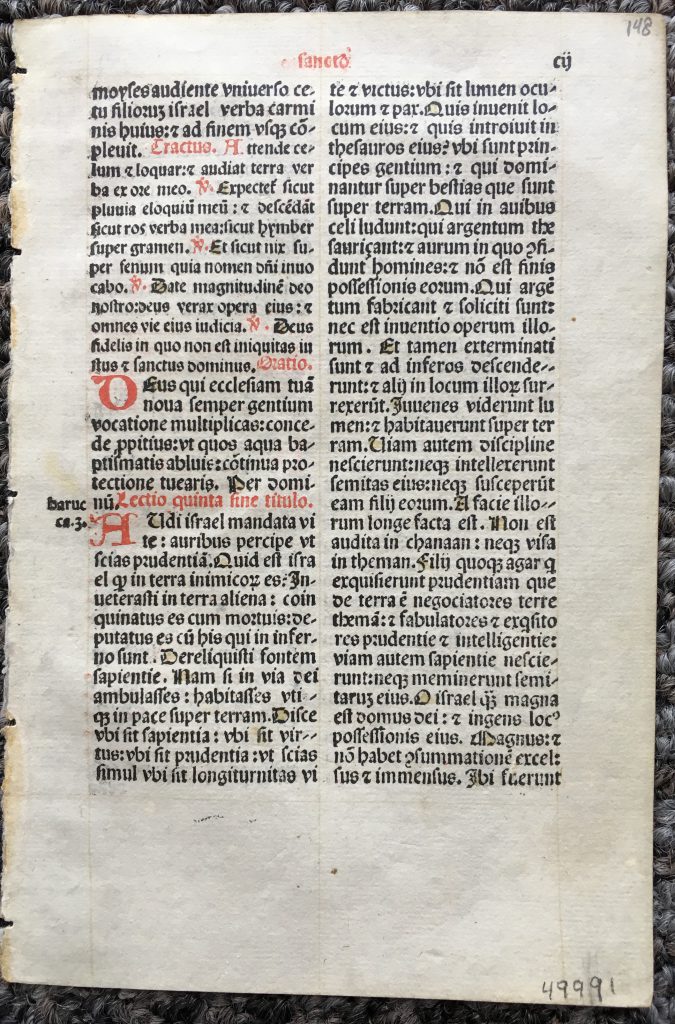
J. S. Wagner Collection, Single Leaf from a Latin Missal containing part of the Mass for Holy Saturday for use in a Carmelite Monastery, printed in 1509 Lucantonio Giunta in Venice. Recto. Reproduced by Permission.
Verso of Leaf, with Catchword
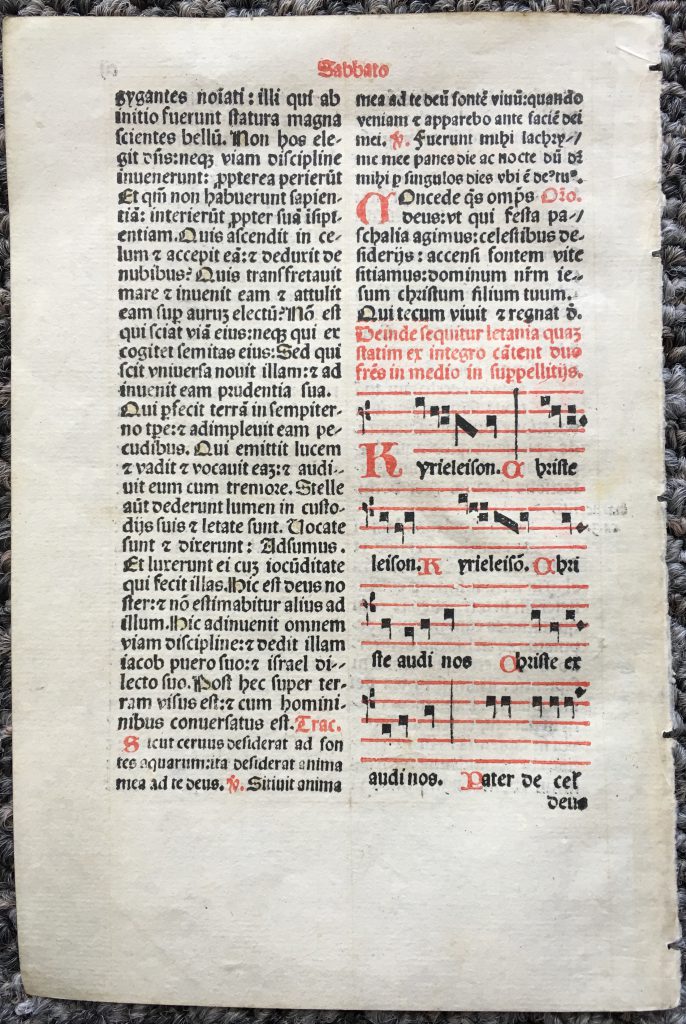
J. S. Wagner Collection, Single Leaf from a Latin Missal (‘Missale Romanum’) containing part of the Mass for Holy Saturday for use in a Carmelite Monastery, printed in 1509 by Lucantonio Giunta in Venice, Italy. Verso of Leaf. Reproduced by Permission.
Features to note: Well, everything. (It’s what we do.)
Including: the Running Title, the Text, the Initials, the Music; and the Yellow Wash. Etc. For example, as showcased in our accompanying Booklet (See Below):

J. S. Wagner Collection, Single Leaf from a Latin Missal containing part of the Mass for Holy Saturday for use in a Carmelite Monastery, printed in 1509 Lucantonio Giunta in Venice. Recto, detail. Reproduced by Permission.
In passing, we note that other blogposts have had occasion to observe the placement of a wash or fill of yellow pigment within minor initials of manuscripts. Some authorities regard the feature as Italian or ‘Italianate’. See, for example
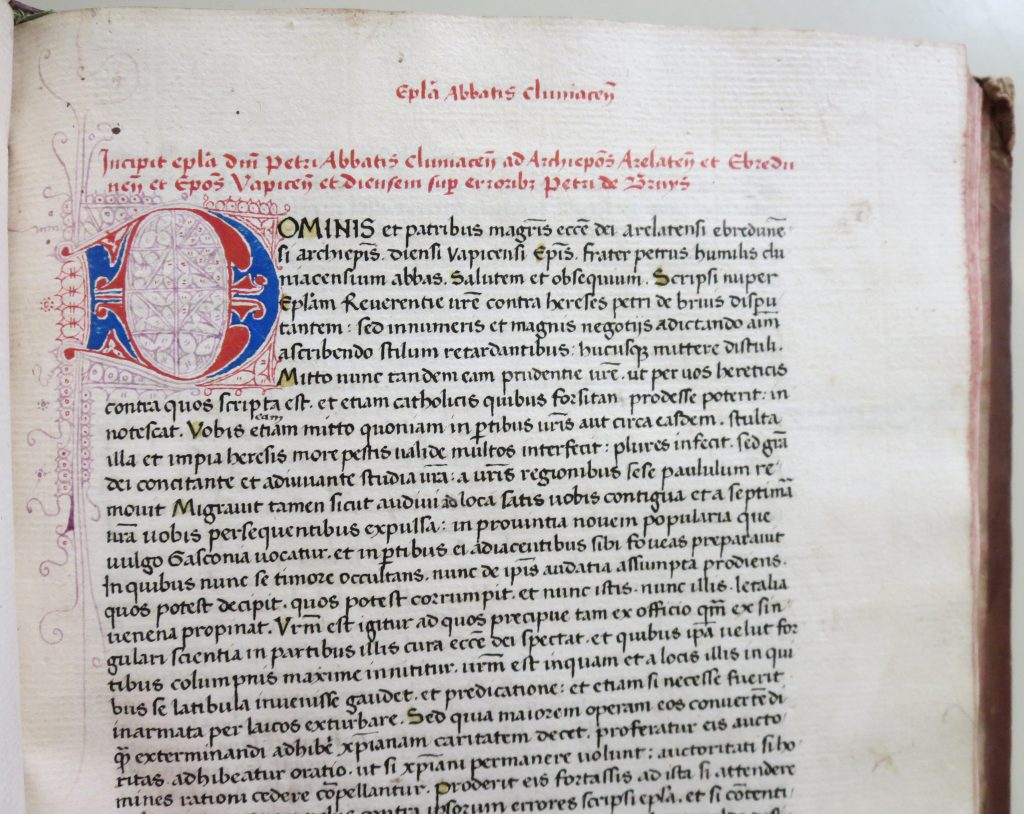
Private Collection, Le Parc Abbey, Theological Volume, Part B, opening page: Peter the Venerable.
Other Leaves From This Dispersed Book
It took a while to find some comparanda, as we continued to explore. You know, we might now wonder (story be told), if that dearth of close comparanda might indicate a rarity, we’d be prepared to agree.
The Report (see below) and this blogpost tell that story.
To start, where we began, once trying to fine some bearings among online resources.
Here is a close relative, exhibited online for sale at one time on ebay and now shown via worthpoint.com as
https://www.worthpoint.com/worthopedia/1509-giunta-missal-leaf-woodcuts-172119411 . It is described thus:
A Leaf From a rare, Giunta Missale, (secundum usum Carmelitarum), numerous woodcuts of New Testament scenes and saints, facing pages with composite borders of figured vignettes, profusion of woodcut historiated and decorative initials. Text and music printed in red and black throughout. The Missal contains the prayers said by the priest at the alter [sic] as well as all that is officially read or sung in connection with the Holy Sacrifice of the Mass throughout the ecclesiastical year. This particular leaf features two woodcuts as well as the text for the Mass that is celebrated during Passion Week for The Easter Season. Verso: Text and music printed in red and black throughout. (Venice: Lucantonio Giunta, 13 January 1509). Condition of this leaf is under fine[F-] and this leaf measures 6.75″ x 4.5″.
Note the generic description that addresses a single “Leaf”, but cites multiple leaves from the same source-volume, as it mentions “numerous woodcuts”, “facing pages with composite borders”, a “profusion of woodcut historiated and decorated initials”, “text and music printed in red and black throughout”, etc., and then refers to features on “this particular leaf”. To whit:
This particular leaf features two woodcuts as well as the text for the Mass that is celebrated during Passion Week for The Easter Season.
Even so, the description could serve for any leaf within the portion dedicated to Passion Week, provided that it has “two woodcuts” and carries music on the verso. Perhaps that is the idea.
(We have become familiar with such a generic approach to identical labels circulated with different individual leaves from a single book in our investigations of manuscripts and other textual materials dispersed from the collection of Otto F. Ege (1888–1951), as considered in multiple posts on our blog; see its Contents List.)
We note the seller’s grading of the condition of that leaf: “under fine” or “F-“, according to recognized book-selling terminology for “used books”. Presumably, if that grading is correct, it could aptly apply to other leaves from the same book, unless, that is, other parts of the book suffered different and more extensive forms of damage.
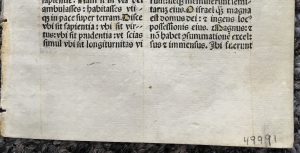
J. S. Wagner Collection, Single Leaf from a Latin Missal printed in 1509 Lucantonio Giunta in Venice. Recto, detail: Bottom Portion. Reproduced by Permission.
According to the image exhibited online in the sales offering, its recto (with a single woodcut) carries the printed folio number liv, and 2 more numbers in pencil: another folio number (“109”) in Arabic numerals in the top right corner, and another number in the bottom right corner (“49952”) — the latter in the same hand as the number 49991 on the Wagner Leaf.
Customarily we could think of such large numbers at bottom right as an inventory number in a seller’s marker. Given the specificity of the number, in a high number not always evenly rounded off, it seems clear that the number is not a price, in whatever currency. Identifying the ‘code’ particular to a given seller might aid in deducing the provenance of the piece. Thus might progress a hunt for a particular seller’s style.
That is how we first regarded the high number on the Wagner Leaf. Further exploration, and the discovery of other leaves carrying similar numbers in a sequence which can be revealed to have a specific import relating to the volume itself, is explained in the Report downloadable below.
Spoiler Alert: We still think that these numbers are inventory numbers, which pertain to the individual leaves of the given volume. But they also appear to stand within a very large inventory which could or would involve very many individual leaves extracted from very many individual books.
The Leaf and its Provenance
The present owner reports that the Leaf came to him in a collection, with no identification of its contents or a source for the item.
And so, exploring aspects in turn of the Missal Leaf — as described here and in the 12-page Report by our Associate (and Font Designer), Leslie J. French (see below) — we have discovered that this very Leaf was listed for Sale via faginarms.com, where it was presented as an Italian Missal Page [Update of 17 November 2020: that post appears to have been removed], with an image clinching the identification:
Straight from the heart of the Renaissance! Printed page, 6 3/4″ x 4 1/2″, by Lucantonio Giunta, Venice, 13 January, 1509. This page with the prayers and songs for Holy Saturday. Excellent and suitable for framing.
Stock Number: FNS3583
Sold
Discovering, if wished, which individual copy of the Missal was dismembered and dispersed, from which collection, and by whom, would require further research.
Other Leaves from the Same Book
Suffice it to say that we have seen online a few other leaves which must have come from the same copy. Mostly, it appears, they passed through eBay. For example, a 1509 Giunta Missal Leaf, described as:
(Venice: Lucantonio Giunta, 13 January 1509).
More leaves are described in our booklet, for which see below.
The Edition and Its Components
Thus, identifying the printer and the date of the edition led us to consult standard bibliographical resources for the genre of book, the printer, Missals printed by the same printer, and other aspects.
First:
- William H. James Weale and Hanns Bohatta, ed., Bibliographica Liturgica: Catalogus Missalium ritus latino ab anno M.CCCC.LXXIV Impressorum (London: Bernard Quaritch, 1928).
An earlier version of the catalogue appears online:
- William H. James Weale, ed., Bibliographica Liturgica: Catalogus Missalium ritus latino ab anno M.CCCC.LXXIV Impressorum (London: Bernard Quaritch, 1886), online via archive.org.
Both versions mention this Missal among the Missals for Use of the Order of the Fratres B. V. Mariae de Monte Carmelo.
But they differ.
In the 1886 version, this Missal is no. 1509 (p. 251), listed only briefly, with the mention of the date and place of publication, and the existence of a copy at “Frankfurt a. M. : S”. I give this detail because you can see its evidence online. I can also report the extra text in the 1928 book, which I possess.
In the 1928 version, this Missal is no. 1887 (p. 319), with more information:
1509, ID. Ian. (13 Jan.) Missale secundum ordinem fratrum Carmelitarum. In Uenetorum ciuitate, Lucas antonius de giunta. 8vo. 44 nn., 299 n., 1 vac = 344 Fol. . . . 2 col. 36 lin.
Frankfurt a. M. : S.
Rivoli 311, 274
That is, in 3 stages:
1) Bibliographical information about the publication itself, its date (the Ides of January, or 13 January, 1509), title, place of printing (“In the City of Venice” or In Uenetorum ciuitate), printer, colophon, format, number of leaves (344), layout in number of columns (2) and lines per page (36), etc.;
2) A known copy of the book, in this case at Frankfurt am Main in the “S[tadtbibliothek].”, however with unspecified pressmark; and
3) The reference to another bibliographical resource, namely “Rivoli” with the numbers “311, 271”.
The 3rd stage refers to a substantial publication by the 3rd Duc de Rivoli (also the Prince d’Essling), Victor Masséna (1836–1910), bibliophile and scholar (see also Essling, Victor Masséna):
- Duc de Rivoli (Victor Masséna), Les Missels imprimés à Venise de 1481 à 1600: Description — Illustration — Bibliographie. Études sur l’art de la Gravure sur Bois (Paris: J. Rothschild, 1894), p. xviii and no. 274 on pages 311–312, online via 1894.
There we find a more detailed description of the volume, according to the single copy examined or known (“l’exemplaire que nous avons vu”) — albeit lacking its title page and some other pages. As a result, the title for the Missal is not reported. The description includes a list of 22 woodcut illustrations, which appear in a cycle from the Immaculée Conception to Christ de pitié — including some which seen to appear also in other Missals printed by or for L.-A. Giunta. Also noted by the description are:
Nombreuses petites vignettes, dont une certaine quantité a fond noir criblé, principalement dans les encadrements qui se trouvent au recto des pages en regard des grands bois. — Initiales ornées.
No mention of the music, but presumably that is to be taken as a given for the genre of book?
The colophon (on R. 288):
Explicit missale per ordinem fratrum gloriosissime dei genitricis semperque virginis marie de monte carmello : … quod impensa sua ac solerti cura Lucasantonius de giunta florentinus in Venetorum ciuitate floretissima impressit. Anno natalis domini. M. d. ix. idibus ianuarij.
(“Here ends the Missal for the Order of the Brothers of the Most Glorious Mother of God and eternal Virgin Mary of Mount Carmel, . . . which, at his expense and by the diligence of skills, Lucas Antonius de Giunta, the Florentine, printed [or caused to be printed?] in the city of Venice. In the year of the Lord, 1509, on the Ides of January.”)
Rivoli identified the sole copy under his consideration as belonging to the city library at Frankfurt, with a pressmark: “Francfort, B[ibliothèque]. de la Ville, Rit. cath. 512”.
In Frankfurt, the Stadtbibliothek now combines with another major institutional library, as the Stadt- und Universitätsbibliothek Frankfurt am Main (since 1945). So far, we have not been able to learn about its copy of this Missal (pressmark “Rit. cath. 512”) through the library website.
The apparent rarity of appearances of copies (or fragments) online or in some standard reference works might show a small-scale printing to start with, or a wider disinterest in the edition as such, given some with earlier dates and/or heightened extents of illustration. If it was a rare issue, then the dismemberment of the volume sold piecemeal online (perhaps not very recently) would represent an even more lamentable loss, with the destruction of the integrity of an early-printed object not easily to be found or replaced elsewhere.
Because Rivoli does not illustrate any of its woodcuts in this edition, we may glimpse their character and perhaps their style from other illustrations of the same subjects in other of Guinta’s Missals which appear among Rivoli’s figures and descriptions. Some of these correspondences or resemblances which Rivoli noted in his entry for this 1509 Missal, by referring to other Missal numbers and to other pages (as with “Missel 59 et p. 167” for the Annonciation XVI, the Assomption (“Cf. pp. 22, 25), and the Nativité de la Ste Vierge (“Cf. p. 113”) — subjects centering upon the Virgin Mary presumably of especial interest to the Carmelites.
Some examples:
A Wonderful Leaf for The Manuscript Collector and A Great Gift Idea! Purchase Three or More Individual Auctions and There Will Be No Charge For Shipping We Now Accept PayPal WE SHIP WORLDWIDE – PLEASE CONTACT US FOR A FREE SHIPPING QUOTE! for more information.
The Printer and His Works
The printer’s career is surveyed in Lucantonio Giunti or Giunta (1457 – 1538), or in English via Lucantonio Giunti. We learn, for example:
Lucantonio Giunta or Giunta (1457–1538) was a Florentine book publisher and printer, active in Venice from 1489, a member of the Giunti family of printers. His publishing business was successful, and among the most important in the late fifteenth and early sixteenth centuries. Through partnerships, often with members of his family, he expanded the business through much of Europe.
It is useful to note that for some works he served directly as printer in the production, and for others indirectly as publisher in the distribution.
The Printer, His Devices, and Examples of Title-Pages
Over the course of his output, Giunta employed several forms of printer’s device. Some are gathered and displayed online via Luca Antonio Giunta. Examples appear in Missals both earlier and later than the 1509 Carmelite Missal, in various formats, and for various Orders, as well for the practices of various Churches — as with the Church of Rome in the Missal Romanum. Some title-pages for his Missals are illustrated in Rivoli (1894).
Here follow a few specimens.
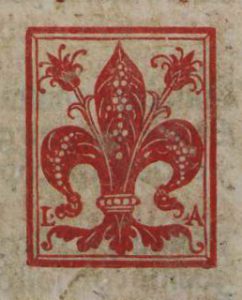
Florence, Biblioteca Nazionale, Missale Romanum printed by Lucantonio Giunta (1521), Title-page, detail: Printer’s Device. Image Public Domain via Wikimedia Commons.
1) From the Roman Missal of 1501 in Folio Format
The title-page of the Missale Romanum nouiter impressum, printed by Lucantonio de Giunta on 20 November 1501 in Venice.
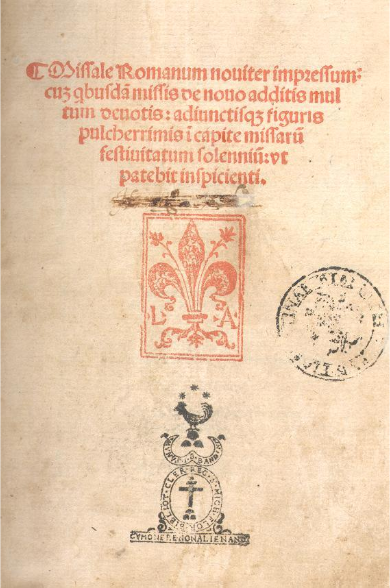
Florence, Biblioteca Nazionale, Missale Romanum printed by Lucantonio Giunta (1501), Title-page. Image via Creative Commons.
The end-page with the colophon displays a mostly full page of text printed in black and red.
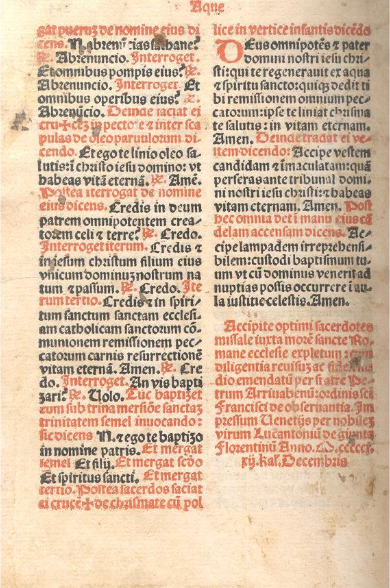
Florence, Biblioteca Nazionale, Missale Romanum printed by Lucantonio Giunta (1501), End-page. Image via Creative Commons.
The edition is listed in Weale and Bohatta (1928), no. 964 (p. 169); and Rivoli (1894), no. 59 (pp. 167–168).
2) For the Dominican Order of 1504 in Folio Format
The title-page of a folio Missale secundum ordinem fratrum Predicatorum, printed by Lucantonio de Giunta on 30 June 1504 in Venice.
The full title, citing the “most beautiful figures (figuris)” describes the work thus:
Missale predicatorum nuper impressum ac emendatum cum multis missis: orationibus pulcherrimisque figuris in capite missarum festiuitatum solennium de nouo superadditis: ut inspicienti patebit.
The edition is listed in Weale and Bohatta (1928), no. 1828 (p. 311); and Rivoli (1894), no. 256 (pp. 300–301).
The tapered title is surmounted by a woodcut illustration of a full-length and haloed figure holding flowers and an edifice, in a depiction of the founder and patron of the Order, the Castilian Saint Dominic (1170–1221). At the bottom of the page appears the printer’s device in an upright rectangular frame, including the initials L and A. The whole volume appears online from a copy still in Venice, at the Biblioteca nazionale Marciana: here. The title-page, from Biblioteca nazionale Marciana – Venezia – IT-VE0049 :
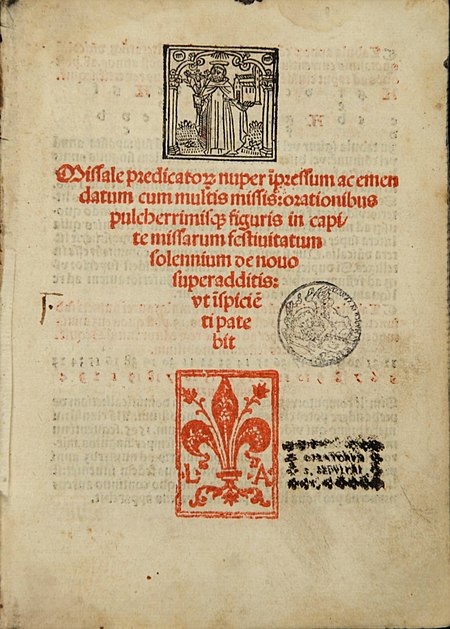
First page of the ‘Missale predicatorum’ (1504), printed by Lucantonio de Giunta in Venice. Image Public Domain via Wikimedia Commons.
3) From a Missal Romanum of 10 May 1521 in Folio Format
That is, Missale romanum nuper adoptatum ad commodum. Venetijs in aedibus Luce antonij de giunta.
The Title page carries a variant version, within a paneled border.
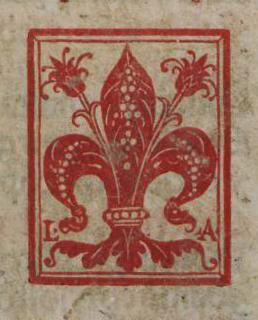
Florence, Biblioteca Nazionale, Missale Romanum printed by Lucantonio Giunta (1521), Title-page, detail: Printer’s Device. Image Public Domain via Wikimedia Commons.
The page in full:
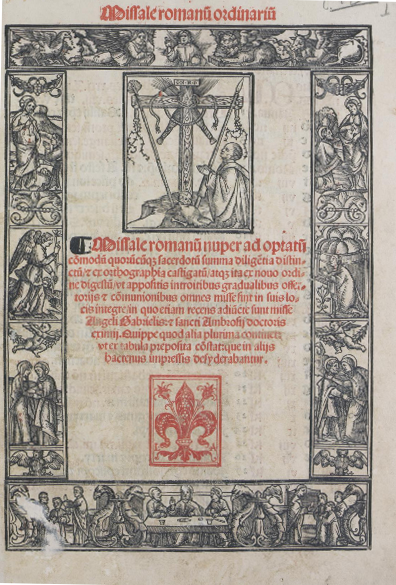
Florence, Biblioteca Nazionale, Missale Romanum printed by Lucantonio Giunta (1521), Illustrated Title-page. Image via Creative Commons.
The detailed title:
Missale Romanum ordinarium. Missale romanum nuper ad optatum comodumquorumcumque sacerdotum summa diligentia distinctum et ortographia castigatum atqueita ex nouo ordine digestum . . .
The edition is Weale and Bohatta (1928), no. 1046 (p. 182); Rivoli (1894), no. 92 (pp. 196–198).
From the copy in Florence, Biblioteca nazionale centrale, shelfmark MAGL.2.109 (identifier info:sbn/CNCE011532), some specimen pages are shown in the Biblioteca digitale italiana via www.internetculturale.it, specifically here. The colophon:
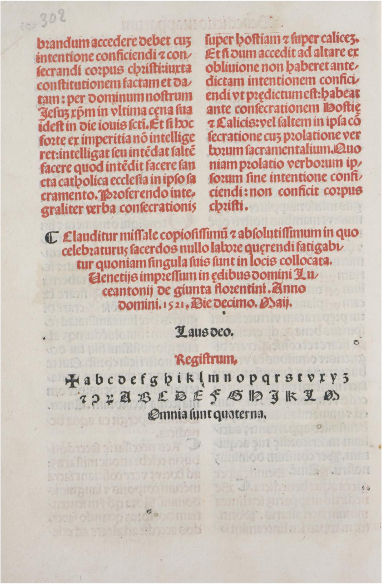
Florence, Biblioteca Nazionale, Missale Romanum printed by Lucantonio Giunta (1521), End Page with Colophon. Image via Creative Commons.
4) From a Missale Nouum of 21 April 1537 for the (Hungarian) Order of Saint Paul the First Hermit in Quarto Format
From a copy in Budapest, National Széchényi Library, I. II, 66:
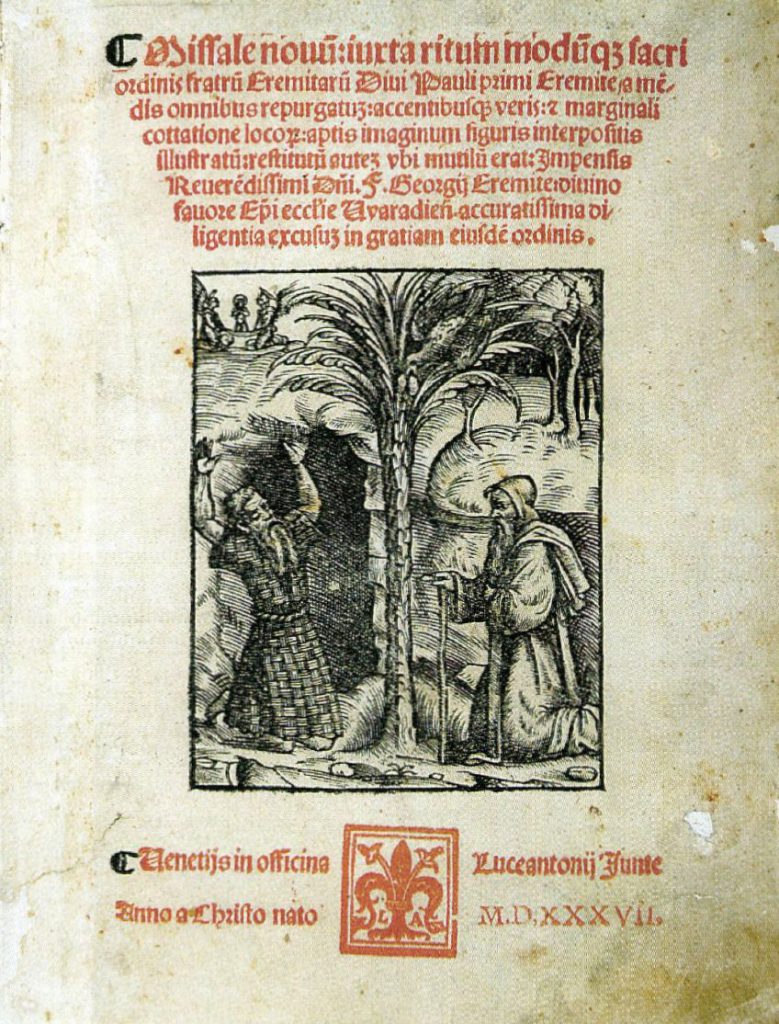
Budapest, National Széchényi Library, I. II, 66, Title-page. Missal (1537). Image Public Domain via Wikimedia Commons.
This edition is Weale and Bohatta (1928), no. 1814 (p. 308); Rivoli (1894), no. 247 (p. 296).
*****
In sum, the Wagner Missal Leaf belongs to a dispersed copy of Guinta’s Missal of 1509 for Carmelite Use.
We offer more information about the leaf and its edition in this 12-page illustrated booklet prepared by our Font and Layout Designer. Free to download. Enjoy!
As customary, we offer the booklet in 2 versions. They might conform with your preferences for viewing and printing.
We thank the owner for permission to examine the material and to present it here. We thank Leslie French for his research and the booklet.
*****
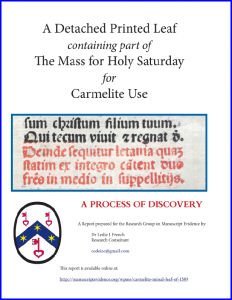
Camelite Booklet Cover Page with New Front Cover with border
Suggestions for Further Reading
More information about this printer, his Missals, and their Music:
- Mary Kay Duggan, Italian Music Incunabula: Printers and Type (Berkeley, etc.: University of California Press, 1992)
- Lesley T. Stone, From Chapel to Chamber: Liturgy and Devotion in Lucantonio Giunta’s Missale romanum, 1508 (M. A. dissertation, Department of Art and Art History, University of South Florida, 2005), examining the edition of 3 October 1508 (especially its woodcuts),
online via https://scholarcommons.usf.edu/cgi/viewcontent.cgi?article=1877&context=etd = University of South Florida Scholar Commons
- Leslie J. French, “A Detached Printed Leaf containing Part of The Mass for Holy Saturday for Carmelite Use: A Process of Discovery” (Princeton: Research Group on Manuscript Evidence, 2020), freely available for download here.
*****
Do you know of other leaves from this Missal? Do you have information about the provenance of this copy?
Please let us know.
Add your Comments here, Contact Us, and visit our Facebook Page.
Follow our blog on blog for further research on dispersed books, and watch its Contents List.

J. S. Wagner Collection, Single Leaf from a Latin Missal containing part of the Mass for Holy Saturday for use in a Carmelite Monastery, printed in 1509 by Lucantonio Giunta in Venice. Recto, detail. Reproduced by Permission.
*****
